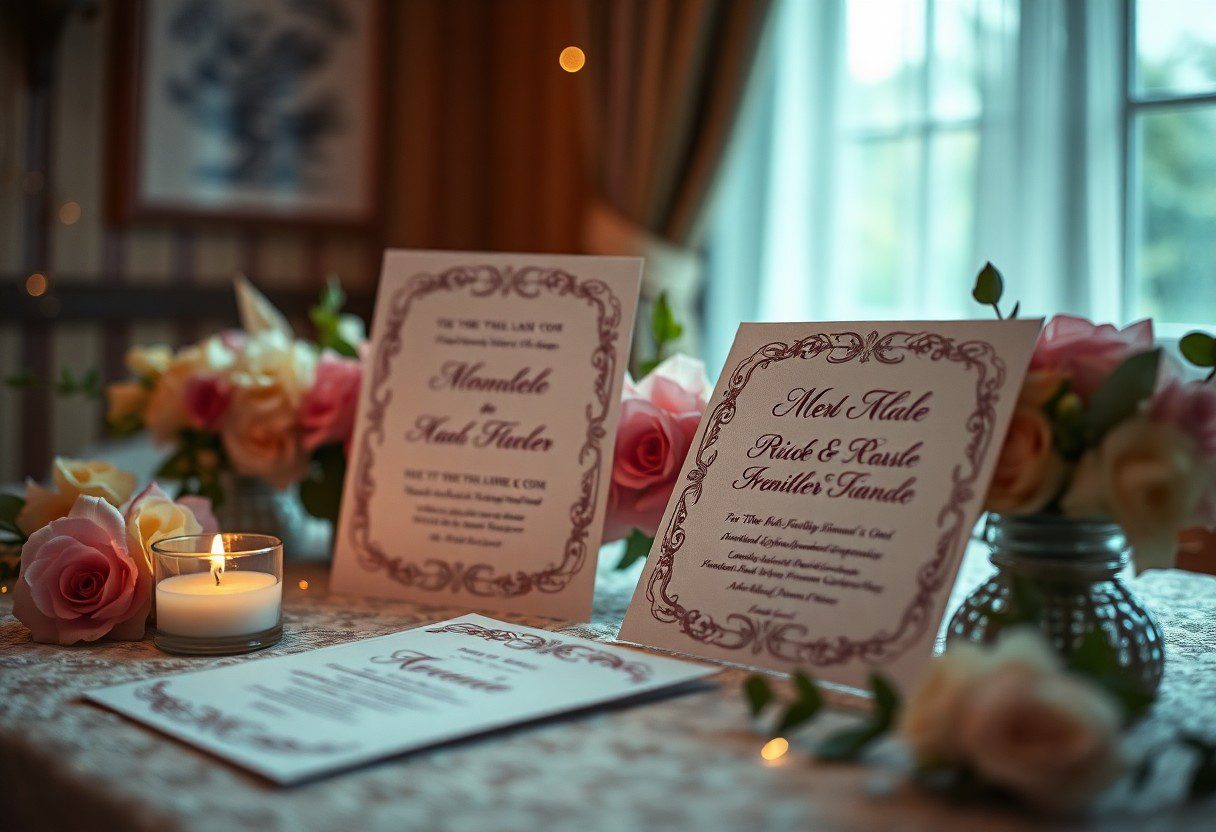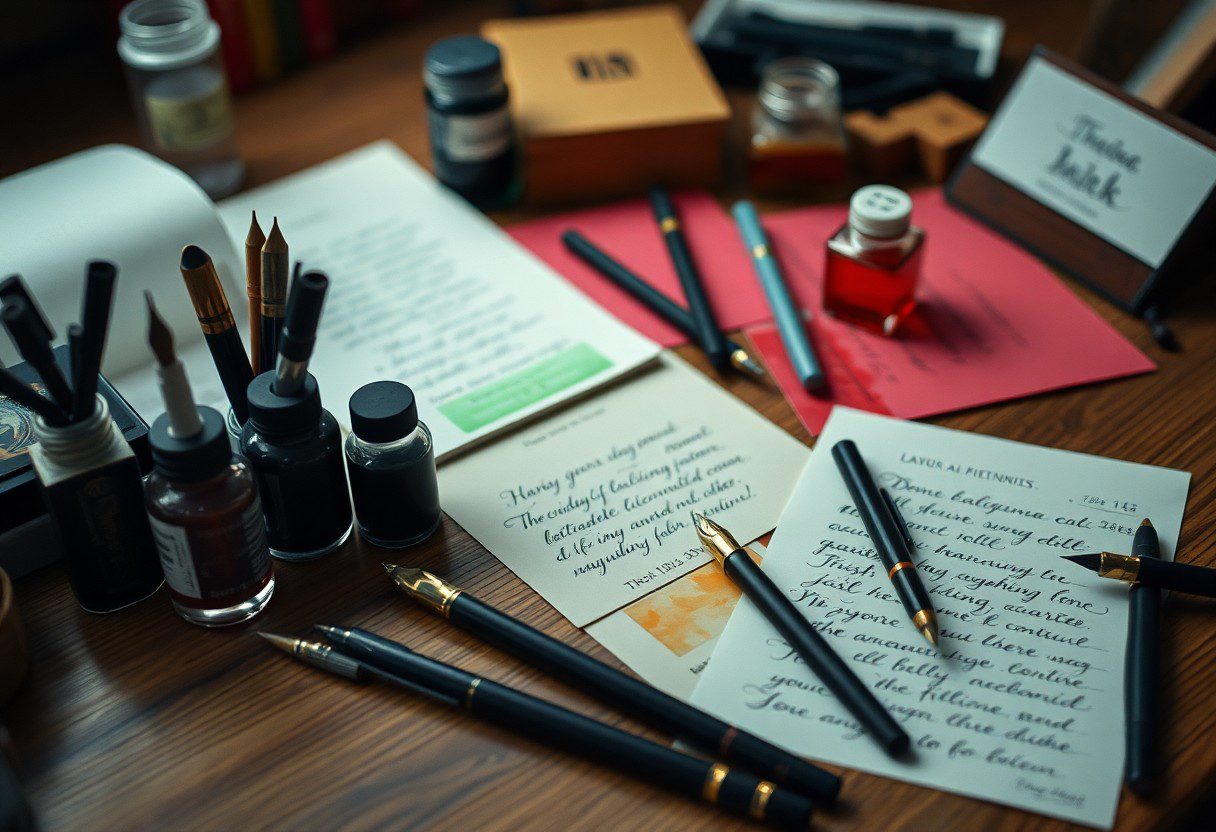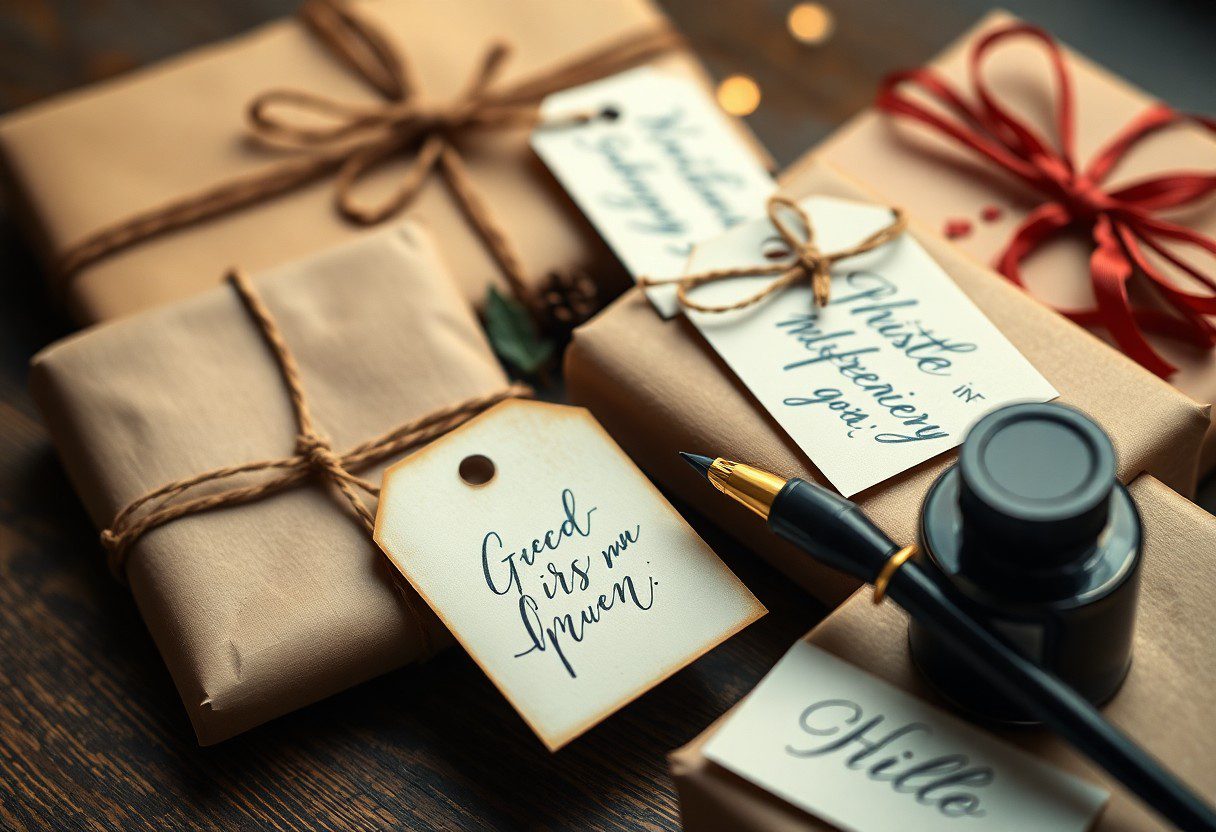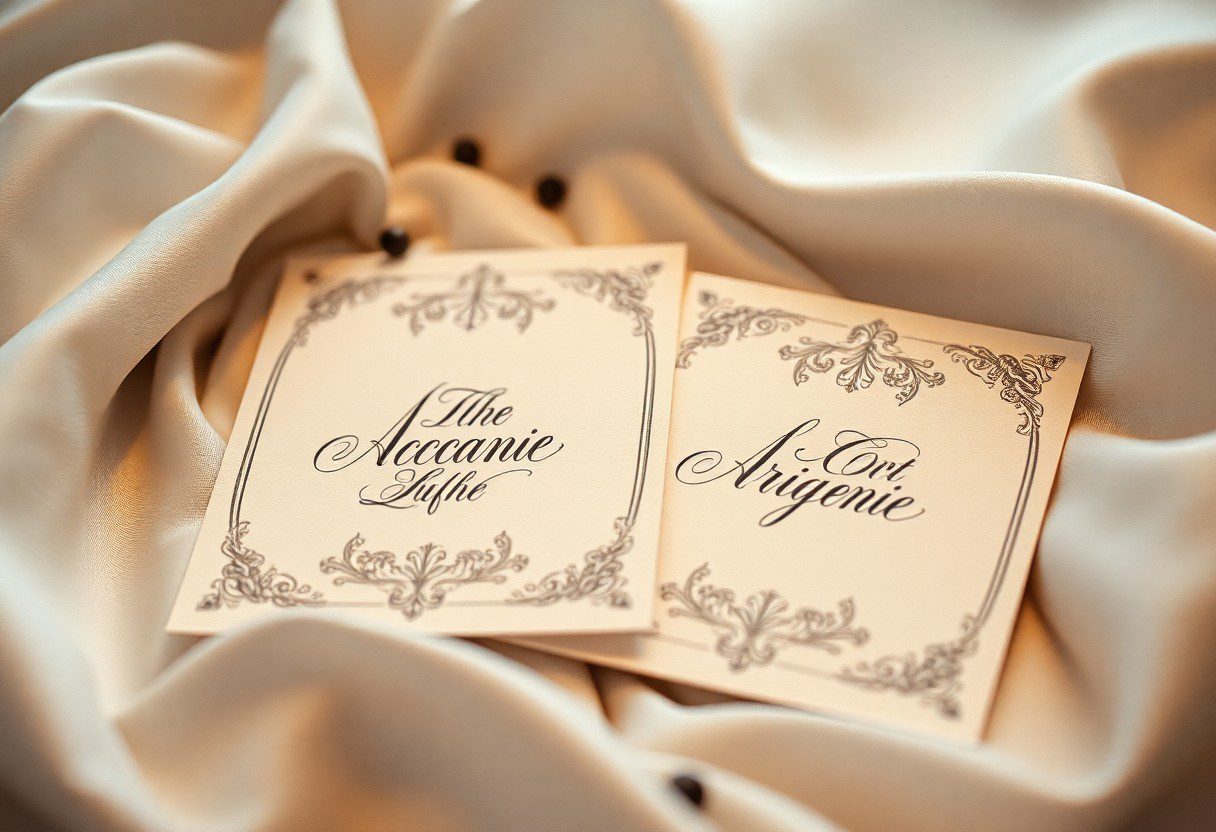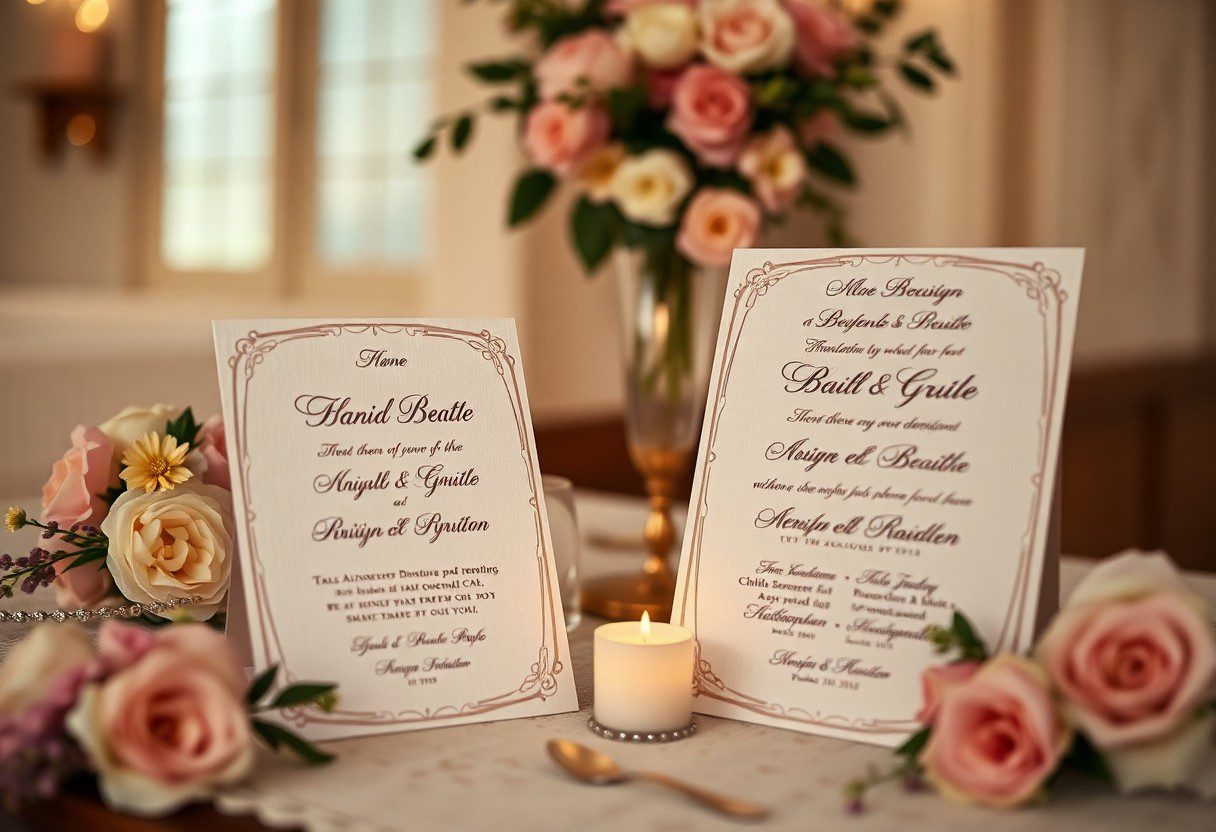Signage plays a vital role in setting the tone for your big day, and incorporating calligraphy into your wedding invitations and signage can add a touch of elegance and personalization. You can elevate your wedding decor by exploring various styles and techniques that reflect your unique love story. From intricate lettering to bold statements, calligraphy can transform ordinary pieces into stunning works of art. In this post, you’ll find diverse calligraphy ideas that will inspire you to create invitations and signage that leave a lasting impression on your guests.
Creative Calligraphy Styles
Modern Calligraphy
By choosing modern calligraphy for your wedding invitations and signage, you invite a personal and artistic flair into your special day. This style breaks away from the rigid traditions of the past, allowing for more expressive letter forms and unique embellishments. You have the opportunity to play with varying line weights, swirls, and loops, creating an invitation that feels both elegant and contemporary. Think about integrating watercolor washes or trendy ink colors to enhance the aesthetic even further, making your stationery truly one-of-a-kind.
Additionally, modern calligraphy can adapt to any theme or color palette you envision for your wedding. Whether your theme is rustic, bohemian, or minimalist, you can customize the calligraphy style to reflect your personal tastes. This flexibility ensures that your invitations and signage not only stand out but also harmonize beautifully with your overall wedding decor, enhancing the experience for you and your guests.
Traditional Calligraphy
Along the path of classic elegance, traditional calligraphy establishes a timeless appeal. Featuring ornate scripts like Copperplate and Spencerian, this style evokes a sense of heritage and formality that resonates especially well with classic wedding themes. By employing traditional calligraphy, you not only honor the art form but also instill a sense of formality and engaged anticipation for your upcoming nuptials. Your invitations will encapsulate the gravitas of such a monumental event, showcasing the effort you’ve invested in creating a memorable experience for everyone involved.
In addition, mastering the intricacies of traditional calligraphy requires practice and skill, giving your stationery an authentic and refined touch. If you’re considering hiring a calligrapher, be sure to review their portfolio and ask about their approach to ensure their style aligns with your vision. Investing in a professional can elevate your wedding signage and invitations into true works of art, leaving a lasting impression on your guests that reflects your commitment to celebrating your love story.
Choosing the Right Materials
The materials you select for your wedding invitations and signage can significantly impact the overall aesthetic and feel of your event. Carefully chosen elements can reflect your personal style and set the tone for your celebration. As you commence on this journey, consider the different options available to you, from paper types to inks and tools, that will best convey your unique vision. Exploring these materials can truly elevate your wedding’s visual appeal while ensuring your designs stand out in today’s saturated market.
Paper Options
An necessary component of your calligraphy work is the paper you choose. Different types of paper can create distinct effects, from smooth vellum to textured cotton. If you opt for a more traditional approach, a high-quality cardstock will lend an air of elegance, while specialty papers—such as handmade or kraft paper—can provide a rustic or vintage touch. It is important to consider the weight and finish of the paper as this will influence the end result of your calligraphy, affecting how the ink lays down and dries.
Inks and Tools
Options abound when it comes to inks and tools, with each choice adding its own flair to your calligraphy. You might prefer classic ink in various hues, such as black, gold, or muted pastels, to bring depth and character to your lettering. Additionally, exploring different pens or brushes—ranging from pointed nibs to broad-tipped brushes—will allow you to discover the best tool for your desired style, whether it be modern or traditional.
Hence, investing in high-quality tools should be a priority because they can greatly affect the ease of your lettering process and the precision of your strokes. Not only will proper tools enhance your final outcome, but using fast-drying, water-resistant inks will help avoid smudges and ensure your invitations and signage remain in pristine condition. As you explore your options, take the time to test various combinations of papers, inks, and tools to find the set that speaks to your personal aesthetic and fulfills your creative endeavor.
Designing Unique Wedding Invitations
Layout and Composition
Above all, the layout and composition of your wedding invitations should reflect your style and set the tone for the entire event. Start by choosing a format that resonates with your aesthetic—whether that’s a classic rectangular shape, a modern square, or a whimsical die-cut design. Pay close attention to the balance of text and whitespace, as this can greatly impact the readability and visual appeal of your invitations. Utilize hierarchies of information, like using larger fonts for crucial details such as names and date, while keeping the information like addresses and RSVP details in smaller fonts. This helps guide the recipient’s eye and enhances the overall design.
Incorporating elements such as imagery or patterns can further enhance your layout. Consider integrating a small illustration or a delicate border that complements your theme, whether it’s floral, vintage, or minimalist. By keeping your layout cohesive and intentional, you ensure that your invites are not only informative but also serve as a beautiful introduction to your wedding day.
Incorporating Personal Elements
For many couples, personalizing wedding invitations is an vital way to make their special day feel unique and intimate. Incorporating personal elements such as your favorite colors, a meaningful quote, or even a custom monogram can imbue your invites with personal significance. Additionally, think about including illustrations that may represent aspects of your relationship—like a favorite place you’ve visited together, or a hobby you both cherish. These touches make your invitations more than just a piece of paper; they tell your love story and invite guests into your journey.
But don’t hesitate to let your creativity shine when it comes to personal elements. Whether it’s adding in an infographic of your love story or choosing a unique typography that reflects your personalities, these details serve to differentiate your invitations from traditional formats. Making the effort to include what is meaningful to you reinforces the warmth and love behind your celebration, ensuring that your guests feel the personal touch every time they look at their invite.
Calligraphy for Wedding Signage
Types of Signage
Your wedding day deserves to be accentuated with exquisite calligraphy signage that reflects your unique style. There are various types of signage you can incorporate into your wedding, each serving a different purpose and enhancing the overall aesthetic. Options include welcome signs, directional signs, menu boards, seating charts, and personal quotes that resonate with your love story. Here’s a breakdown of some popular types:
| Welcome Signs | Greet guests with a beautiful introduction to your special day. |
| Directional Signs | Guide guests effortlessly to key areas, ensuring everyone knows where to go. |
| Menu Boards | Display your culinary offerings in an elegant manner. |
| Seating Charts | Help guests find their tables easily while adding a touch of class. |
| Personal Quotes | Enhance your décor with meaningful phrases that reflect your journey. |
Thou can create a truly enchanting ambiance with the right combination of calligraphy signage options. You can utilize various materials and styles to match your theme perfectly.
Placement and Visibility
Below, the strategic placement of your calligraphy signage is vital to ensuring that guests can navigate seamlessly throughout your wedding venue. You want to ensure that your signs are easily visible, directing guests to various locations such as the ceremony area, reception, and restrooms. Consider the flow of movement and the natural pathways your guests will take when placing signs. Bright colors, appropriate size, and clear fonts will help your signage stand out, making information readily accessible to all.
With the optimal placement and visibility of your calligraphy signage, you can enhance guest experience significantly. Pay attention to where your guests will congregate the most and position key signs in those areas. Using contrasting colors for your calligraphy can add emphasis and ensure clarity, while positioning them at eye-level can improve readability. Additionally, consider using frames or stands that match your wedding décor for an attractive presentation. By focusing on these elements, thou will create a welcoming atmosphere throughout your celebration.
DIY Calligraphy Tips
Many aspiring calligraphers often seek to enhance their skills to create stunning wedding invitations and signage. Here are some tips to help you begin your DIY calligraphy journey:
- Choose the right tools: Invest in high-quality calligraphy pens and ink for the best results.
- Practice consistently: Dedicate time each week to improve your lettering techniques.
- Experiment with styles: Explore different calligraphy styles to find the one that resonates most with your vision.
- Utilize resources: Make use of online tutorials and classes to refine your skills.
Recognizing the importance of practice and the right tools will set you on the path to creating unique and beautiful calligraphy for your special day.
Practice Techniques
After you gather your materials, begin by mastering basic strokes and letter formations. Create a structured practice schedule that allows you to focus on different alphabets and styles. You might find it helpful to use guide sheets or templates to ensure accuracy in your strokes. Regularly practicing these foundational elements will give you the confidence to tackle more complex projects, such as your wedding invitations.
Don’t hesitate to experiment with various surfaces, such as textured paper or even fabric, as this can yield exciting results. As you develop your skills, try to mimic styles you admire, and explore how the flow of letters can create a unique personality in your work. Soon enough, you will start to identify your own style and voice within the art of calligraphy.
Common Mistakes to Avoid
Among the various challenges that beginners face in calligraphy, a few common pitfalls can hinder your progress. One prevalent mistake is not maintaining proper posture while writing, which can lead to fatigue and inconsistent line quality. Additionally, rushing through letters may result in shaky lines and uneven spacing. Lastly, neglecting to clean your tools can interfere with ink flow, detracting from the overall quality of your work.
Tips to avoid these issues include prioritizing ergonomics during your practice sessions; ensure your posture is upright and relaxed. Make it a habit to take your time—slow and deliberate movements result in more cohesive letterforms. Lastly, always clean your calligraphy pens and brushes after each use to maintain optimal ink flow. By actively working to correct these common errors, you will build a strong foundation for your calligraphy projects, ultimately resulting in exceptional designs.
Hiring a Professional Calligrapher
Despite the allure of tackling calligraphy on your own, hiring a professional calligrapher can elevate your wedding invitations and signage to an entirely new level of artistry. Their expertise ensures that every stroke is precise, resulting in a beautifully crafted presentation that reflects your style and vision. Professionals not only possess the technical skills but can also advise you on the best techniques and materials that align with your theme, ensuring a polished and cohesive look throughout your wedding stationery.
Finding the Right Artist
Below are key factors to consider when searching for the perfect calligrapher for your wedding. Start by browsing online portfolios and social media platforms, as they showcase each artist’s unique style and versatility. Ask for recommendations from friends or fellow brides if they have used calligraphy services before. Once you’ve shortlisted a few artists, reach out to them to discuss your ideas, timelines, and budget; communication is vital to ensure the artist can deliver what you envision.
Budgeting for Calligraphy Services
Against popular belief, investing in a professional calligrapher can be both rewarding and budget-friendly, depending on your approach. It’s key to understand that prices can vary widely based on the calligrapher’s experience, materials used, and the complexity of your designs. Set a clear budget beforehand and communicate this with your chosen artist, as they may offer different packages or services tailored to meet your financial needs while still maintaining quality.
Due to the varying levels of skill and artistry in the calligraphy field, you should be prepared for a range of pricing options. Many professional calligraphers charge per piece or offer packages for bulk orders, like invitations, envelopes, and signage. You might find a reputable artist who provides exceptional work at a price that won’t break your budget, but be cautious of offers that seem too good to be true. Investing in high-quality calligraphy not only enhances the aesthetic of your wedding but also gives a personal touch that will be cherished by both you and your guests.
To Wrap Up
With this in mind, incorporating calligraphy into your wedding invitations and signage can elevate the overall elegance of your event. By selecting unique styles that reflect your personal taste and the theme of your wedding, you can create a stunning visual experience that captivates your guests from the first glance. Consider experimenting with various mediums, such as handwritten notes or digitally printed designs, to achieve your desired effect. This artistic touch not only adds a personal flair but also sets the tone for your special day.
Ultimately, the choices you make regarding calligraphy can leave a lasting impression on your guests. Whether you opt for traditional script, modern lettering, or something entirely bespoke, make sure it aligns with your vision. As you incorporate these calligraphic elements into your wedding, you’ll find that they can serve not only as functional pieces but also as treasured mementos that reflect the love and joy of your celebration. Embrace the beauty of calligraphy and watch as your wedding invitations and signage become cherished works of art.
FAQ
Q: What are some popular calligraphy styles for wedding invitations?
A: Some popular calligraphy styles for wedding invitations include modern calligraphy, which features fluid and artistic letters; classic or traditional calligraphy, known for its ornate and elegant lettering; and brush calligraphy, which uses a brush pen for a more contemporary look. Each style can be customized to fit the theme of the wedding, enhancing the overall aesthetic of the invitations.
Q: How can I incorporate calligraphy in my wedding signage?
A: Incorporating calligraphy in wedding signage can be done through various formats, such as welcome signs, seating charts, and place cards. Using wood, acrylic, or chalkboards as backgrounds allows for creative expression. Additionally, incorporating decorative elements like florals and illustrations can enhance the overall design, making your signage cohesive with the wedding theme.
Q: What materials are best for calligraphy on invitations?
A: The best materials for calligraphy on invitations include high-quality paper options such as cotton, linen, or specialty textured papers that complement the ink. Using ink that contrasts well with the paper, such as gold or silver for dark papers, can provide a striking effect. It’s also important to consider using a calligraphy-friendly pen or nib to achieve clean and elegant letters.
Q: Can I DIY my calligraphy invitations if I have no experience?
A: Yes, you can DIY your calligraphy invitations even if you’re a beginner. Start by practicing basic strokes and letters using calligraphy worksheets, focusing on one style at a time. Invest in a beginner’s calligraphy kit that includes a nib, ink, and practice paper. You might begin with simpler designs and gradually work on more intricate pieces as your confidence grows.
Q: How do I choose the right color scheme for my calligraphy?
A: Choosing the right color scheme for your calligraphy involves considering the wedding colors and overall theme. Popular choices include combining neutral tones with metallics for a chic look or vibrant hues for a more playful and modern aesthetic. Additionally, ensure that the color of the ink contrasts enough with the background to maintain readability, while also enhancing the overall design.
